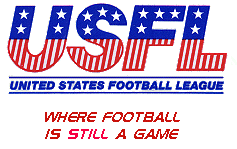|
The USFL was concieved May 11th, 1982, the brainchild of David Dixon, an antiques dealer
from New Orleans who believed football in the spring and summer would work.Peter Spivak, a judge, was named the league's interim
president until Chet Simmons, a broadcasting executive from ESPN, became the head honcho.
The league began play in the spring of 1983 with the Tampa Bay Bandits winning the inagural
game, 21-17, over the Boston Breakers. Although play improved throughout the season and ESPN and ABC were happy with
the ratings, all but two teams lost money. The Michigan Panthers, led by quarterback Bobby Hebert, won the league's first
championship, 24 to 22 over the Philadelphia Stars.
The Stars came back with a vengeance in 1984, winning 16 games and capturing the USFL's
title over the upstart Arizona Wranglers. Although rising player salaries caused serious trouble for some franchises, the
league did have some success that year. Six more teams and stars like Jim Kelly, Mike Rozier, Steve Young and Reggie White
were inked, giving the young league more credibility. After the season ended, Chet Simmons was removed his position as commisoner
and replaced by Harry Usher.
 |
 |
|

The USFL Championship Trophy
|
USFL Champions
1983 at Denver
Michigan Panthers 23, Philadelphia Stars 22
1984 at Tampa
Philadelphia Stars 24, Arizona Wranglers 3
1985 at the Meadowlands
Baltimore Stars 28, Oakland Invaders 24
The winners of two semi-final games faced each other in a neutral site for
the USFL Championship.
|
|
 |
 |
In 1985, things started to go downhill. The league began to resemble the World Football League, with empty stadiums
and constant franschise movements and collapses. The league then filed a 1.7 billion dollar anti-trust lawsuit against
the National Football League for monopolizing the television market for professional football, thus preventing the USFL from
gaining a lucrative TV contract. The league then declared that it would be moving to a fall schedule for 1986, forcing teams
like Houston and New Orleans, which occupied NFL stadiums, to find new homes. The league played its best football in 1985,
but the season ended with the league's future in doubt, 160 million dollars in debt.
A month before the 1986 campaign was to begin, the jury reached a verdict. They determined
the NFL was a monopoly but the USFL's problems were of its own doing. The USFL was awarded one dollar for its efforts ( trebled
to $3 ), which meant the league would come up $159,999,997 short. It disbanded shortly before the 1986 season was scheduled
to begin. The final nail in the coffin was hammered home early in 1988 when the USFL lost its last appeal in th 2nd Circut
Court of Appeals in New York. Steve Ehrhart, a league executive, still holds on to the uncashed check.
Still, the USFL's legacy lives on. Two of the league's new ideas, Instant Replay and the
two-point conversion, were adopted by the NFL in the 1990s. The time stoppage after a first down inside 2 minutes exists in
college.
|
 |
|

